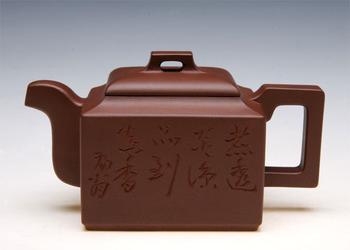 The teapot is best known for its production in Yixing, at least a thousand years ago. In the middle of the Northern Song Dynasty, the teapot began to be widely used. However, the early production process of the purple sander was rather poor, and there were more round pots, mainly for boiling tea and drinking water. The pot with genuine collection is the product after the middle of the Ming Dynasty. In the late Ming Dynasty, the purple sand process had a great development. Zisha pots are increasingly sophisticated, various styles, endless, it is beautiful, giving a visual enjoyment, so a lot of Yixing teapot has become a royal imperial items.
The teapot is best known for its production in Yixing, at least a thousand years ago. In the middle of the Northern Song Dynasty, the teapot began to be widely used. However, the early production process of the purple sander was rather poor, and there were more round pots, mainly for boiling tea and drinking water. The pot with genuine collection is the product after the middle of the Ming Dynasty. In the late Ming Dynasty, the purple sand process had a great development. Zisha pots are increasingly sophisticated, various styles, endless, it is beautiful, giving a visual enjoyment, so a lot of Yixing teapot has become a royal imperial items. This caused the Chinese to drink tea, and Zisha Hu was preferred. Because of its intrinsic practical value and its external ornamental value, the teapot is favored by more and more people. Many collectors have a great preference for it. Since its creation, the teapot has been characterized by its simple and elegant artistic style and the color, fragrance and taste of the tea. It has greatly appreciated the tea artists of the past and has been regarded as the most ideal tea set.
Although the current teapot style is more and more, more and more fancy. However, the purple sand art developed over the centuries has slowly converged into a system and a whole. Since the Northern Song Dynasty, the Zi Sha Hu has been a continuous artist and has formed a relatively complete art system. Today we have come to talk about the following systems:
(1) Material system. Zisha entertainers used mud for mining, screening, and mud training. In the Ming Dynasty, Dabin and other purple sands had formed a unique treatment method for the special mud produced in the Yixing region, and the allocation of various purple clay soils and firing temperatures. And a variety of subtle changes and coloration have systematic and scientific experience.
(2) Process system. The teapot, born from stoneware, uses a unique method of tapping and splicing. This process excavates the characteristics of purple clay. In the middle and late Ming Dynasty, the tools for making teapots were basically the same as modern tools. It is already complete. In the purple sand handicrafts, tapping, matting, and squeezing spouts are also complete. This process is full of ceramic handmade charm and still attracts ceramic artists from around the world to study and visit Yixing.
(3) The firing system. From blending with stoneware to burning with a box, sticking to impurities, mastering the temperature level, and grasping the atmosphere in the kiln, the clay teapots can be optimally presented.
The above three teapot systems seem to have little to do with the artistry. In fact, they are the basis of the entire Zishahu art system, and the appreciation of the teapot art is based on the beauty of the texture of the clay, the skillfulness and smoothness of the process, and the firing. The fire is just right and so on.
(4) modeling system. Zi Sha Hu can be described in the shape of ever-changing, but which is a rule to follow. According to the shape classification Zisha pot can be divided into light goods, flower goods, tendon products, and according to different morphological characteristics, can be divided into round, square, vegetarian and other categories.
(5) Decoration system. The Yixing teapot is in principle mainly to make full use of the inherent texture of the purple sand puddle, and the decorative effect of the shape and mud color changes. Zisha pots often complete the decoration process at the same time in the molding process, such as the decoration of the lines and the use of the arc surface on the arc surface. In addition to the sculptural self-decoration, there are seal descriptions, colored glaze decoration, mud painting decoration, and commonly used calligraphy and painting pottery decoration. The cultural connotation of the decorative image, the various life, history, and aesthetic experience that are loaded on it make the artistic system of the teapot an increasingly rich cultural heritage.
(6) The humanities system. The ancient arts and crafts are masters who bring **, passed down from generation to generation, and are best known for producing in Yixing. Naturally, when the products are exaggerated, the workers are even more obliged. This almost makes the teapot unburied, and using a teapot to make Puerh tea is best. Pu'er tea made of Pu'er tea preserves the color, aroma and taste of Pu-erh tea and it tastes great!
Pillow Cases,Throw Pillow Cases,Lamb Fur Pillow Cases,Lamb Fur Throw Pillow Cases
Ning Xia Most Glory International Trading Co., Ltd. , https://www.nxmostglory.com